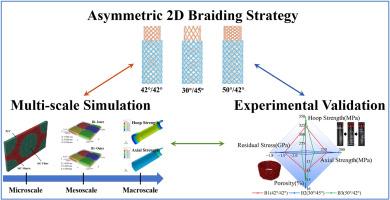SiC/SiC复合材料核燃料包壳环向和轴向强度平衡的非对称二维编织策略
IF 14.2
1区 材料科学
Q1 ENGINEERING, MULTIDISCIPLINARY
引用次数: 0
摘要
为了解决核反应堆SiC/SiC复合材料包层的倒环向和轴向强度挑战,本研究引入了一种创新的非对称二维(2D)编织设计。建立了多尺度模型,对不同编织结构包层的力学性能进行了预测。利用化学气相渗透/化学气相沉积(CVI/CVD)工艺,制备了编织角分别为30°/45°和50°/42°的梯度编织试样,系统揭示了编织角对材料力学性能的调控机制。结果表明,内编织角对复合材料力学性能的影响更为显著,而外编织角设计可以弥补内编织角对复合材料力学性能的影响,从而克服传统对称设计中环向强度与轴向强度的固有冲突。拉曼光谱显示,大角度编织结构(50°)的残余压应力为- 2.07 GPa,有助于通过预应力强化提高环箍强度。参数加权分析表明,内层编织角主要决定环向强度,而轴向强度受编织角和孔隙率共同调节。该研究为核燃料包壳性能的多目标优化提供了理论基础。本文章由计算机程序翻译,如有差异,请以英文原文为准。

An asymmetric 2D braiding strategy for balancing hoop and axial strength in SiC/SiC composite nuclear fuel cladding
To address the challenge of inverted hoop and axial strength in SiC/SiC composite cladding for nuclear reactors, this study introduces an innovative asymmetric two-dimensional (2D) braided design. A multi-scale model was constructed to predict the mechanical properties of the claddings with different braiding structures. Leveraging a chemical vapor infiltration/chemical vapor deposition (CVI/CVD) process, gradient braided specimens with braiding angles of 30°/45° and 50°/42° were fabricated to systematically reveal the regulatory mechanism of the braiding angle on mechanical properties. Results indicate that the inner braid angle has a more significant impact on mechanical properties, while the outer braid design can compensate for the mechanical property deficiencies caused by the inner braid angle, thereby overcoming the inherent conflict between hoop and axial strengths in traditional symmetric designs. Raman spectroscopy revealed a residual compressive stress of −2.07 GPa in the large-angle braiding structure (50°), contributing to improved hoop strength via prestress strengthening. Parameter weighting analysis indicated that the inner-layer braiding angle primarily dictates hoop strength, while axial strength is co-regulated by both braiding angle and porosity. This research provides a theoretical foundation for multi-objective optimization of nuclear fuel cladding performance.
求助全文
通过发布文献求助,成功后即可免费获取论文全文。
去求助
来源期刊

Composites Part B: Engineering
工程技术-材料科学:复合
CiteScore
24.40
自引率
11.50%
发文量
784
审稿时长
21 days
期刊介绍:
Composites Part B: Engineering is a journal that publishes impactful research of high quality on composite materials. This research is supported by fundamental mechanics and materials science and engineering approaches. The targeted research can cover a wide range of length scales, ranging from nano to micro and meso, and even to the full product and structure level. The journal specifically focuses on engineering applications that involve high performance composites. These applications can range from low volume and high cost to high volume and low cost composite development.
The main goal of the journal is to provide a platform for the prompt publication of original and high quality research. The emphasis is on design, development, modeling, validation, and manufacturing of engineering details and concepts. The journal welcomes both basic research papers and proposals for review articles. Authors are encouraged to address challenges across various application areas. These areas include, but are not limited to, aerospace, automotive, and other surface transportation. The journal also covers energy-related applications, with a focus on renewable energy. Other application areas include infrastructure, off-shore and maritime projects, health care technology, and recreational products.
 求助内容:
求助内容: 应助结果提醒方式:
应助结果提醒方式:


